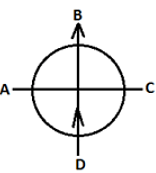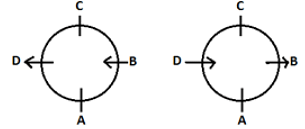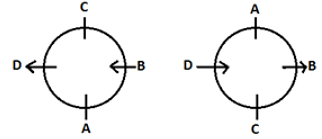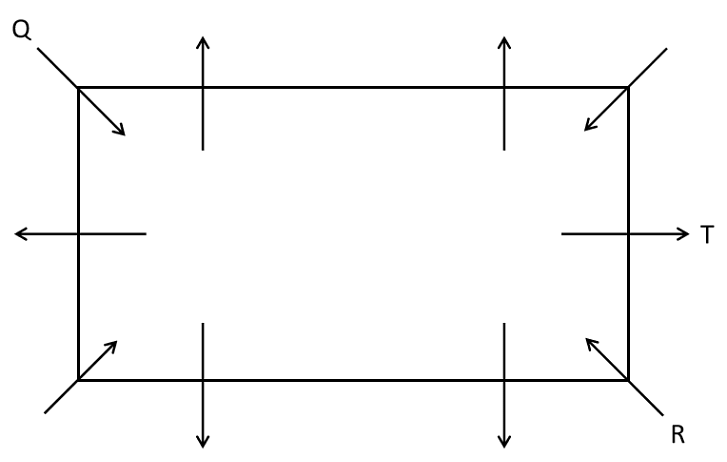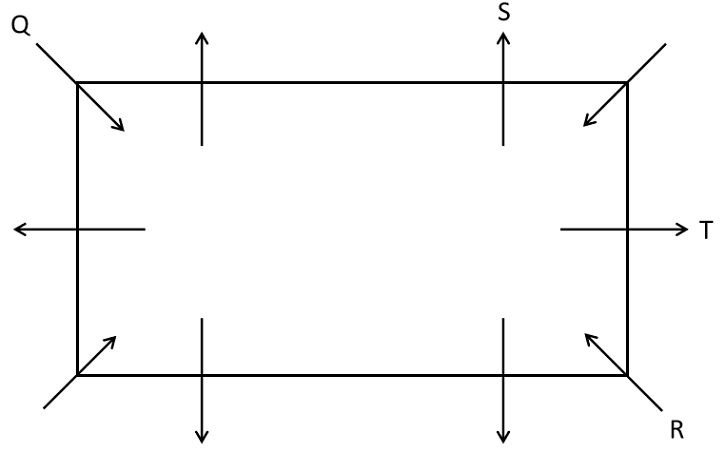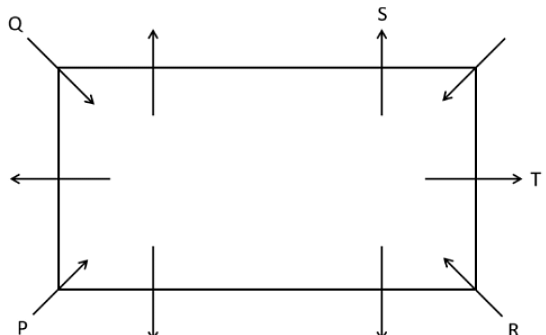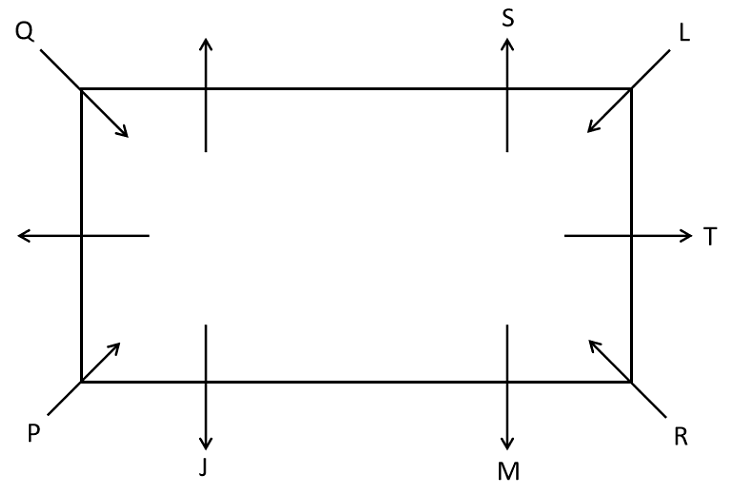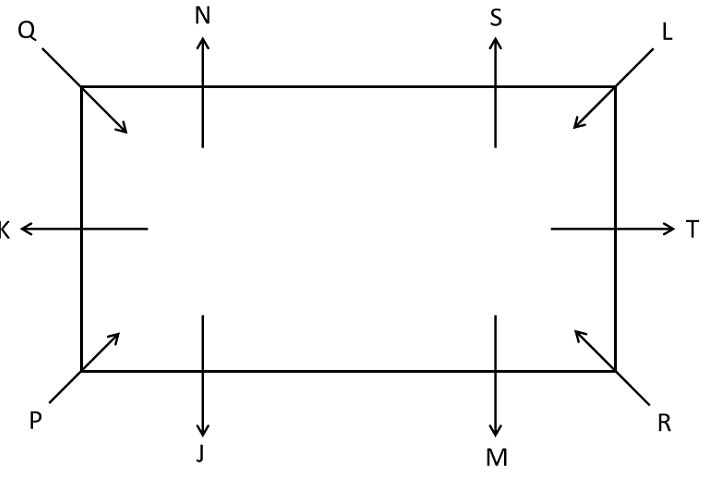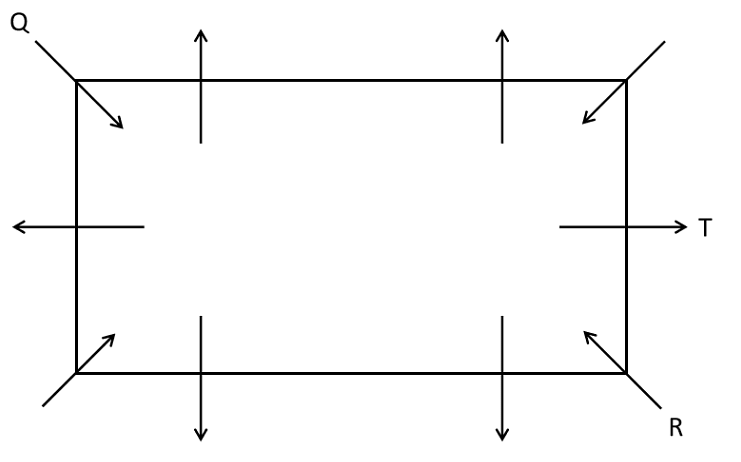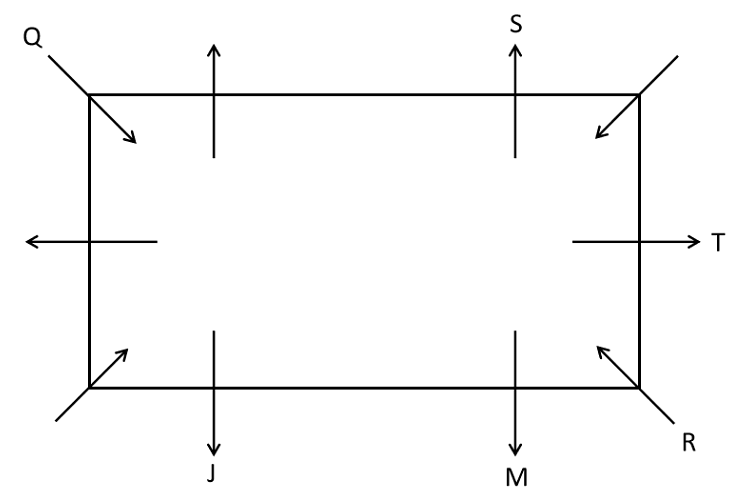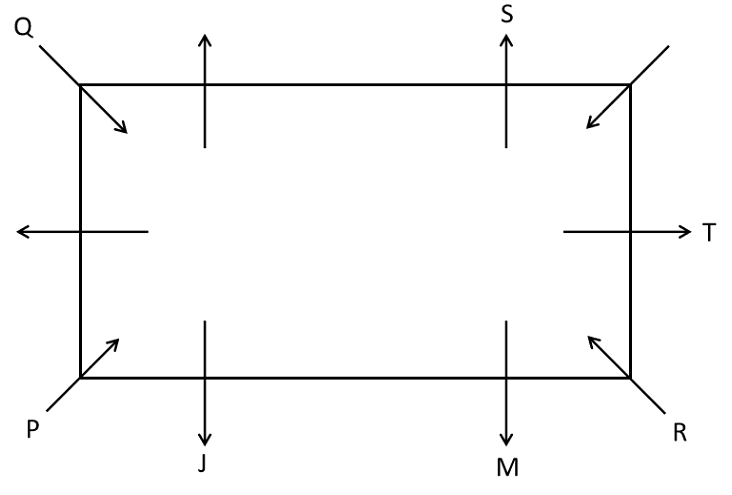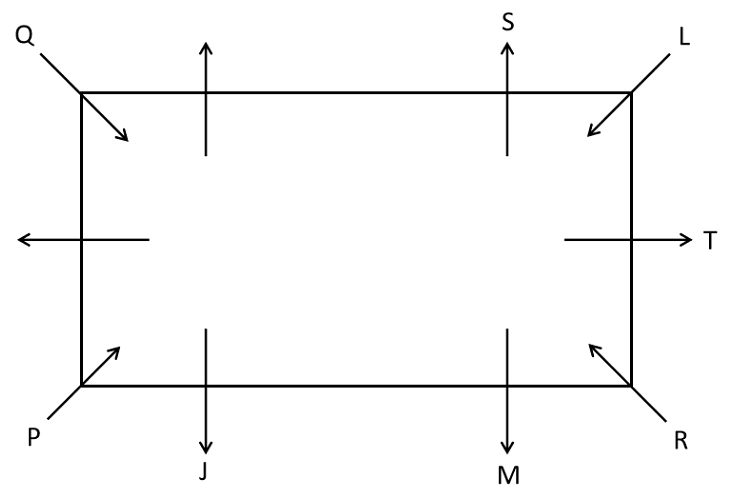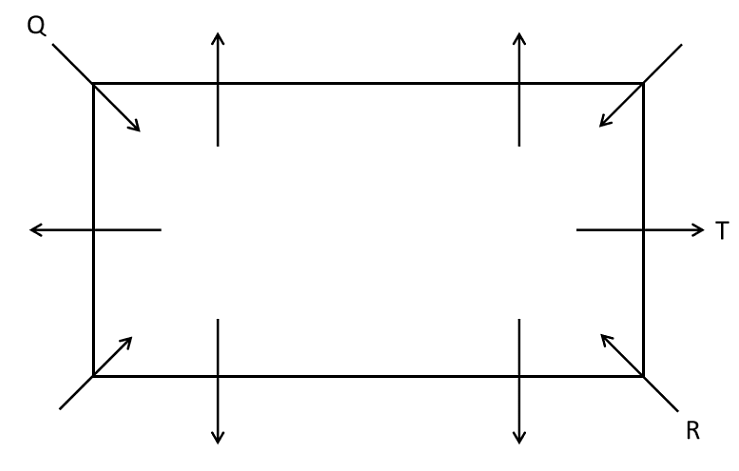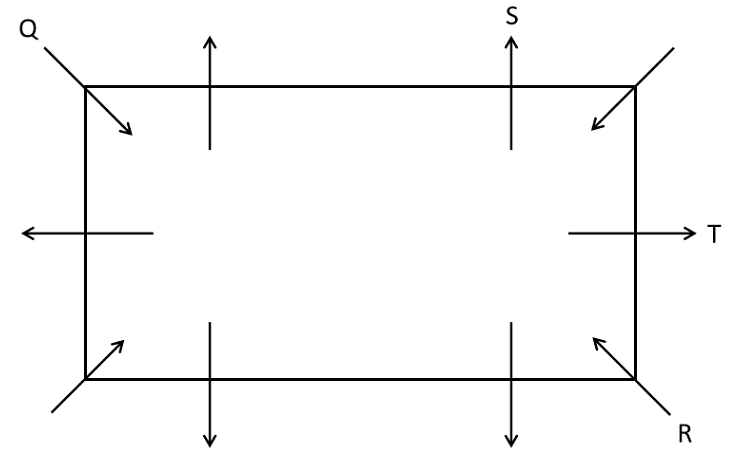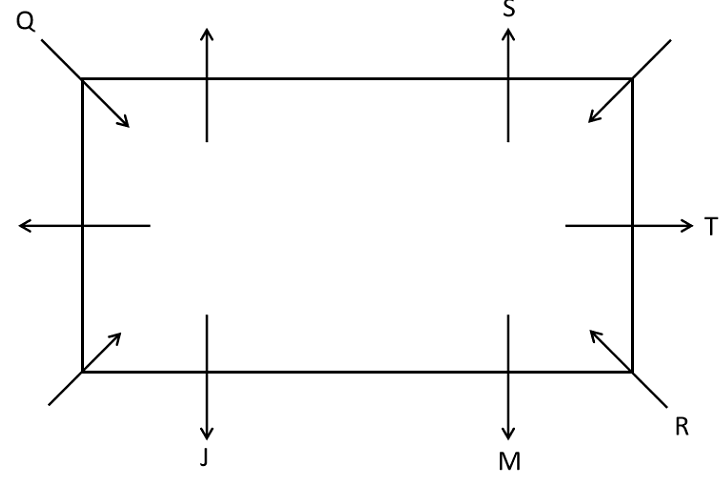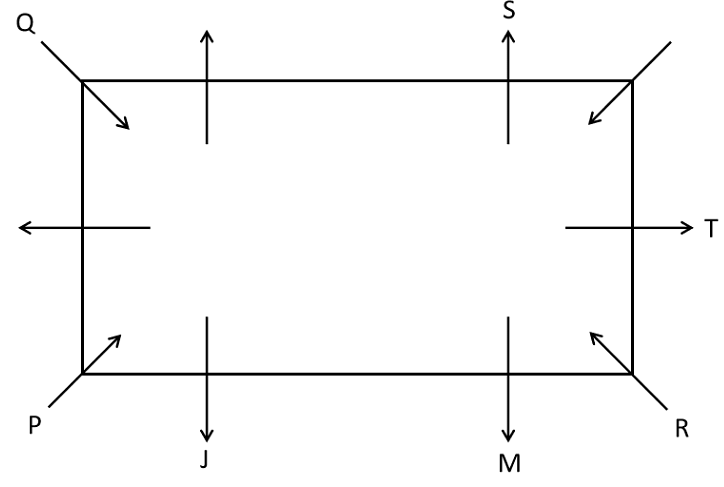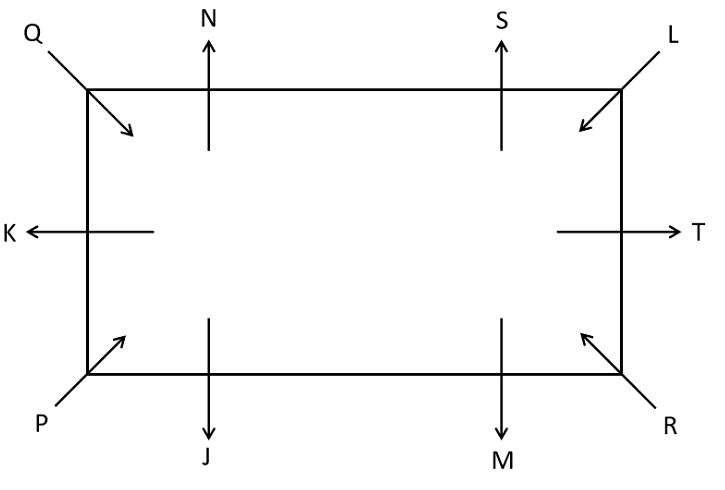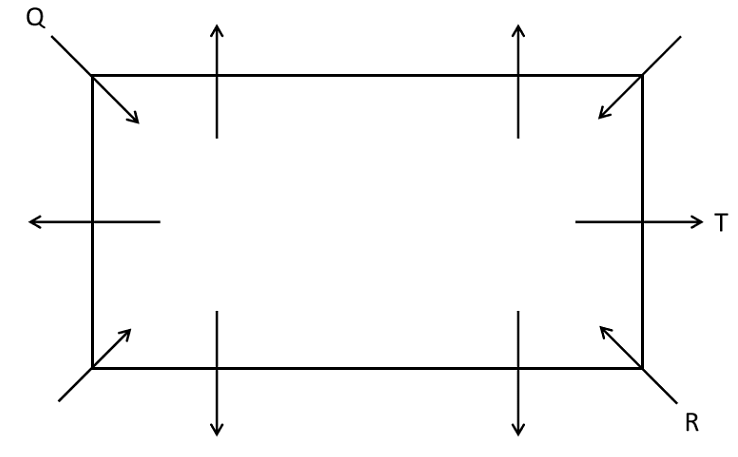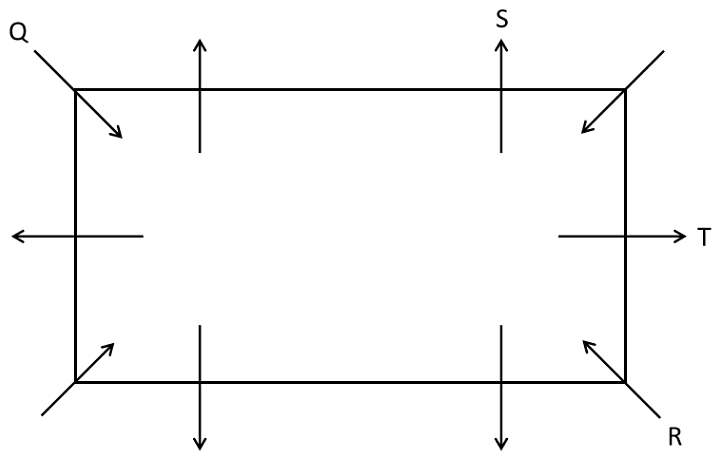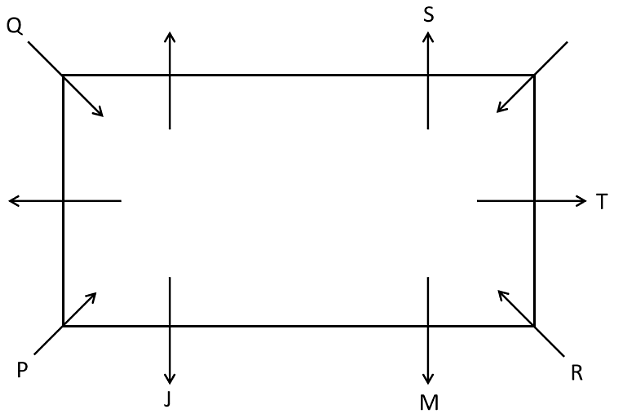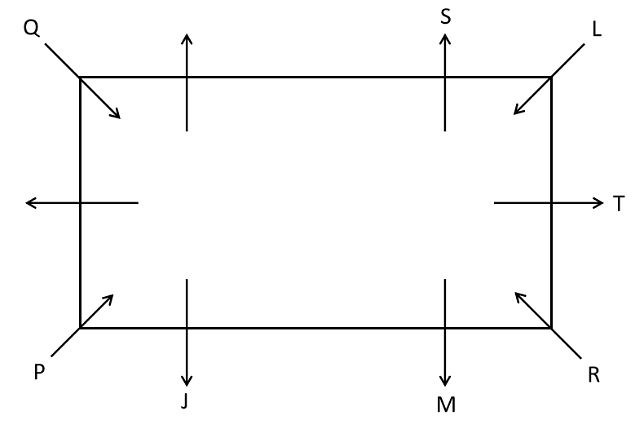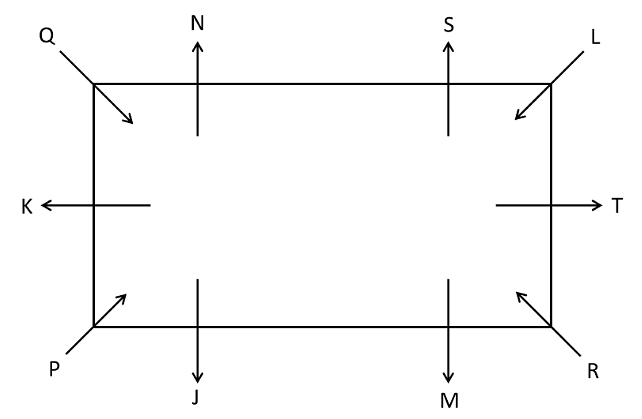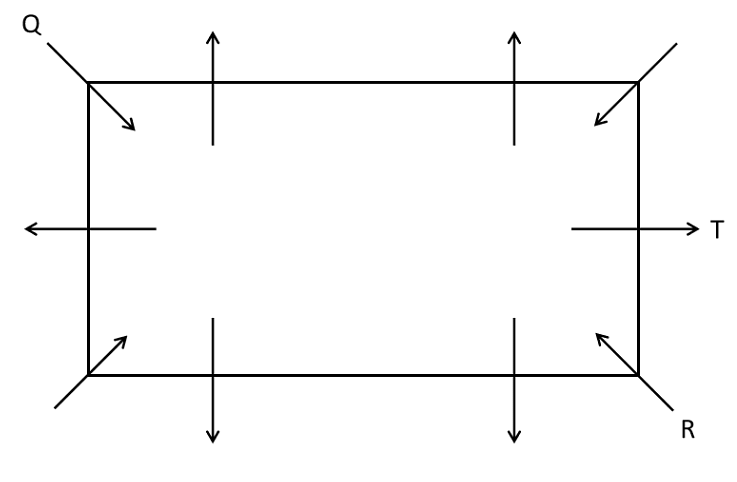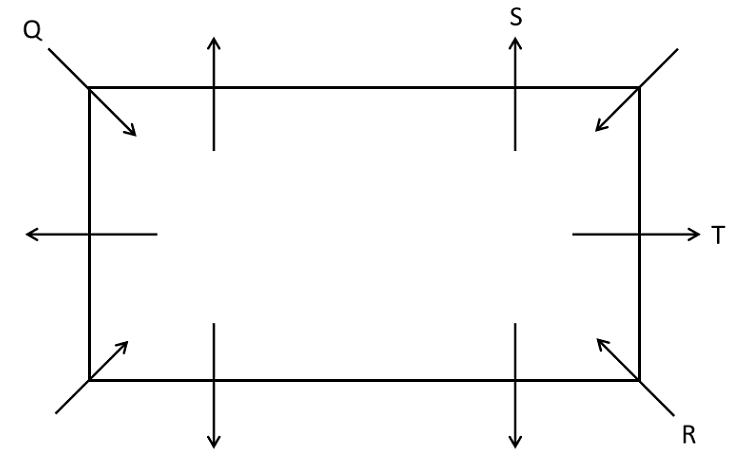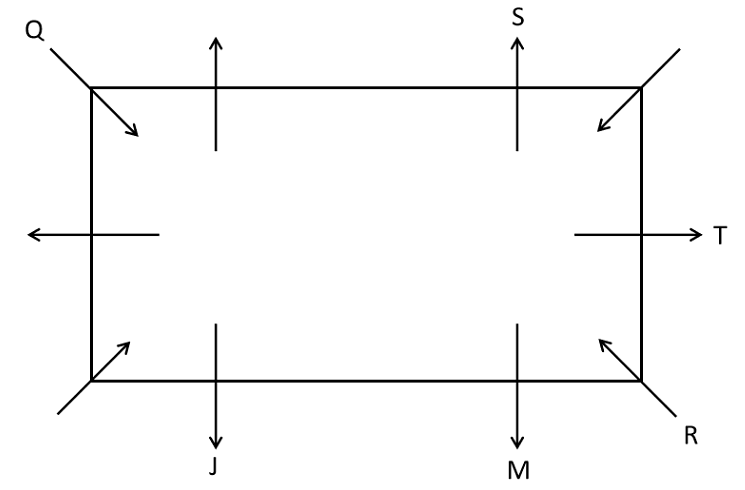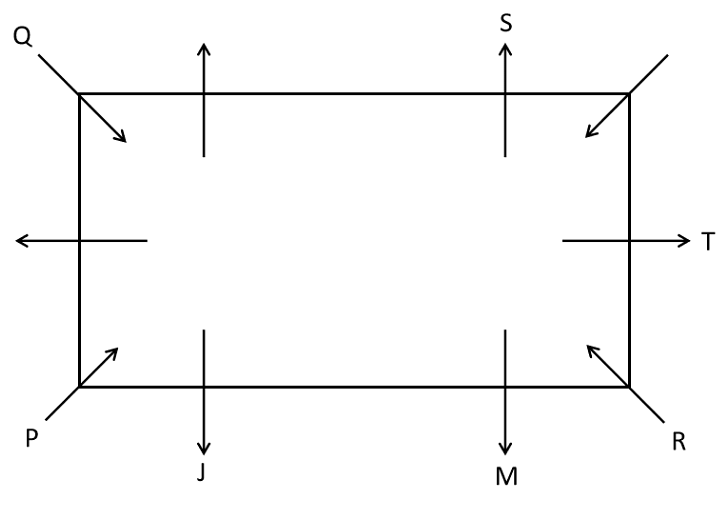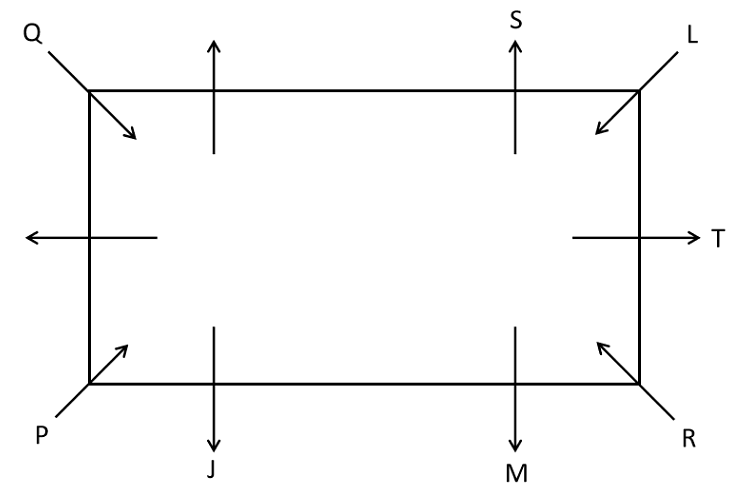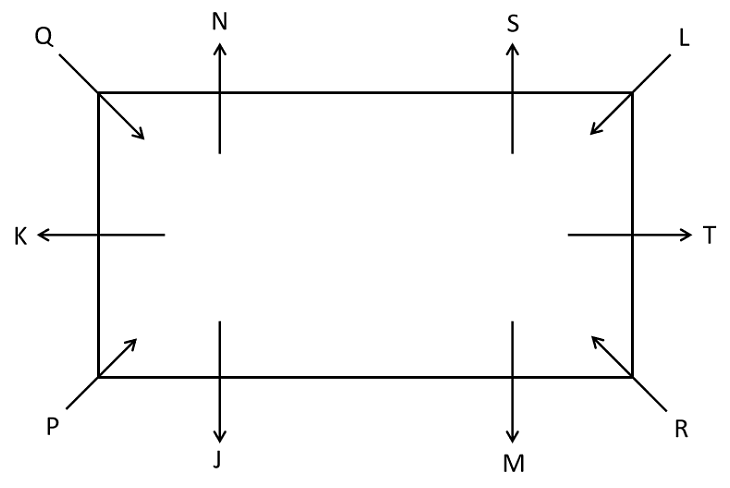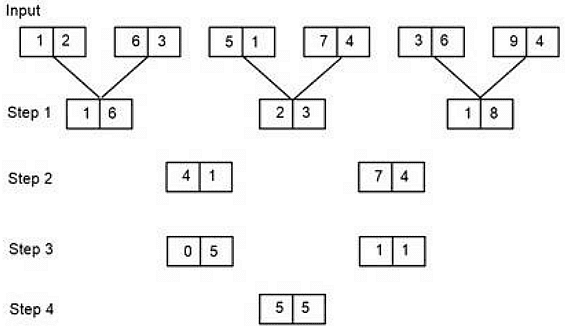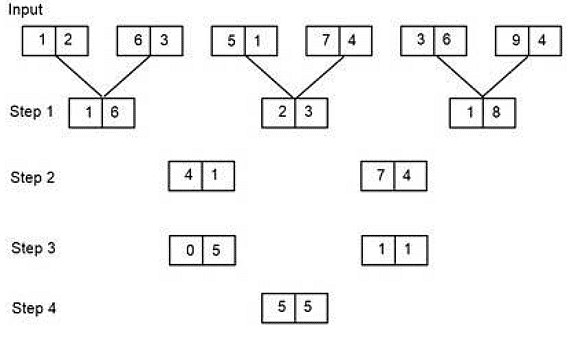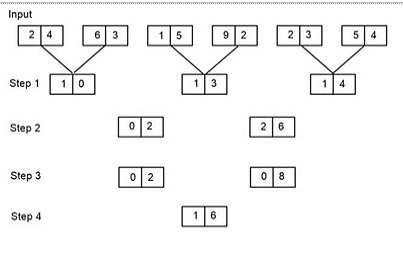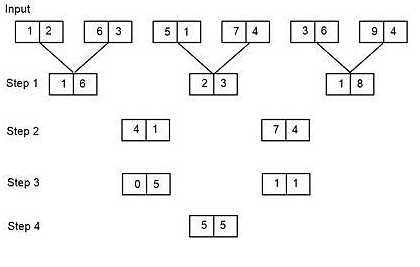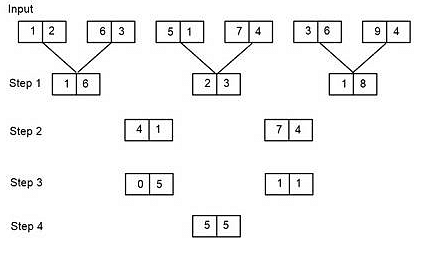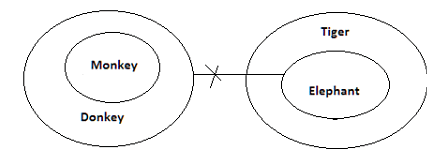IBPS RRB Clerk Mains Mock Test - 10 - Bank Exams MCQ
30 Questions MCQ Test Mock Tests for Banking Exams 2024 - IBPS RRB Clerk Mains Mock Test - 10
Ten people are sitting in two parallel rows such as five people sit in each row. K, L, M, N, O are sitting in Row 1 and face in the north direction. Remaining people R, S, T, U and V are sitting in Row 2 faces in the south direction. The person in each row faces the person in the other row. Each person is having a different amount (in Rs.).
The sum of the amount which T has and the amount which M has is equal to Rs. 50. One person is sitting between L and the one who faces the person who has Rs. 48. The amount which S has is Rs. 1 less than the half the amount which N has. The difference between the amount which M has and the amount which R is equal to the amount which V has. U does not sit at any of the extreme ends of the row. One person is sitting between M and K. No person has an amount less than Rs. 5. The one who has Rs. 15 is an immediate neighbour of one who has either Rs. 10 or Rs. 12. U does not face L. The one who faces K is second to the right of V. The amount which O has is Rs. 8 less than the amount which K’s immediate neighbour has. N is to the left of O who doesn't face V. The amount which U has is double the amount which O has. The amount which T has is the multiple of five. M is second to the left of one who faces S. The one who has Rs. 48 is immediately right of V. The amount which R has is Rs. 8 less than the amount which T has.
Q. The person who has Rs. 20 faces which of the following people?
Ten people are sitting in two parallel rows such as five people sit in each row. K, L, M, N, O are sitting in Row 1 and face in the north direction. Remaining people R, S, T, U and V are sitting in Row 2 faces in the south direction. The person in each row faces the person in the other row. Each person is having a different amount (in Rs.).
The sum of the amount which T has and the amount which M has is equal to Rs. 50. One person is sitting between L and the one who faces the person who has Rs. 48. The amount which S has is Rs. 1 less than the half the amount which N has. The difference between the amount which M has and the amount which R is equal to the amount which V has. U does not sit at any of the extreme ends of the row. One person is sitting between M and K. No person has an amount less than Rs. 5. The one who has Rs. 15 is an immediate neighbour of one who has either Rs. 10 or Rs. 12. U does not face L. The one who faces K is second to the right of V. The amount which O has is Rs. 8 less than the amount which K’s immediate neighbour has. N is to the left of O who doesn't face V. The amount which U has is double the amount which O has. The amount which T has is the multiple of five. M is second to the left of one who faces S. The one who has Rs. 48 is immediately right of V. The amount which R has is Rs. 8 less than the amount which T has.
Q. Which of the following is odd?
| 1 Crore+ students have signed up on EduRev. Have you? Download the App |
Ten people are sitting in two parallel rows such as five people sit in each row. K, L, M, N, O are sitting in Row 1 and face in the north direction. Remaining people R, S, T, U and V are sitting in Row 2 faces in the south direction. The person in each row faces the person in the other row. Each person is having a different amount (in Rs.).
The sum of the amount which T has and the amount which M has is equal to Rs. 50. One person is sitting between L and the one who faces the person who has Rs. 48. The amount which S has is Rs. 1 less than the half the amount which N has. The difference between the amount which M has and the amount which R is equal to the amount which V has. U does not sit at any of the extreme ends of the row. One person is sitting between M and K. No person has an amount less than Rs. 5. The one who has Rs. 15 is an immediate neighbour of one who has either Rs. 10 or Rs. 12. U does not face L. The one who faces K is second to the right of V. The amount which O has is Rs. 8 less than the amount which K’s immediate neighbour has. N is to the left of O who doesn't face V. The amount which U has is double the amount which O has. The amount which T has is the multiple of five. M is second to the left of one who faces S. The one who has Rs. 48 is immediately right of V. The amount which R has is Rs. 8 less than the amount which T has.
Q. How many people have an odd numbered amount?
Ten people are sitting in two parallel rows such as five people sit in each row. K, L, M, N, O are sitting in Row 1 and face in the north direction. Remaining people R, S, T, U and V are sitting in Row 2 faces in the south direction. The person in each row faces the person in the other row. Each person is having a different amount (in Rs.).
The sum of the amount which T has and the amount which M has is equal to Rs. 50. One person is sitting between L and the one who faces the person who has Rs. 48. The amount which S has is Rs. 1 less than the half the amount which N has. The difference between the amount which M has and the amount which R is equal to the amount which V has. U does not sit at any of the extreme ends of the row. One person is sitting between M and K. No person has an amount less than Rs. 5. The one who has Rs. 15 is an immediate neighbour of one who has either Rs. 10 or Rs. 12. U does not face L. The one who faces K is second to the right of V. The amount which O has is Rs. 8 less than the amount which K’s immediate neighbour has. N is to the left of O who doesn't face V. The amount which U has is double the amount which O has. The amount which T has is the multiple of five. M is second to the left of one who faces S. The one who has Rs. 48 is immediately right of V. The amount which R has is Rs. 8 less than the amount which T has.
Q. What is the amount which V has?
Ten people are sitting in two parallel rows such as five people sit in each row. K, L, M, N, O are sitting in Row 1 and face in the north direction. Remaining people R, S, T, U and V are sitting in Row 2 faces in the south direction. The person in each row faces the person in the other row. Each person is having a different amount (in Rs.).
The sum of the amount which T has and the amount which M has is equal to Rs. 50. One person is sitting between L and the one who faces the person who has Rs. 48. The amount which S has is Rs. 1 less than the half the amount which N has. The difference between the amount which M has and the amount which R is equal to the amount which V has. U does not sit at any of the extreme ends of the row. One person is sitting between M and K. No person has an amount less than Rs. 5. The one who has Rs. 15 is an immediate neighbour of one who has either Rs. 10 or Rs. 12. U does not face L. The one who faces K is second to the right of V. The amount which O has is Rs. 8 less than the amount which K’s immediate neighbour has. N is to the left of O who doesn't face V. The amount which U has is double the amount which O has. The amount which T has is the multiple of five. M is second to the left of one who faces S. The one who has Rs. 48 is immediately right of V. The amount which R has is Rs. 8 less than the amount which T has.
Q. How many people’s amount cannot be obtained definitely from the given information?
Read the following information carefully and answer the questions given below.
! → North
^ → South
* → West
$ → East
# → Either 5 or 9 meters
& → Either 3 or 8 meters
A ^ B means A is south of B.
A & B means A is either 3 or 8 meters from B.
A !* B means A is north-west of B.
A * # B means A is west of B, and A is either 5 or 9 meters from B.
Point P is 5 meters north of point Q, which is 6 meters away from point R.
I. S $ P
II. P & S
III. T !& S
IV. U *# T
V. U !* Q
VI. R ^& U
VII. R * Q
Q. What is the direction of point P with respect to point U?
Read the following information carefully and answer the questions given below.
! → North
^ → South
* → West
$ → East
# → Either 5 or 9 meters
& → Either 3 or 8 meters
A ^ B means A is south of B.
A & B means A is either 3 or 8 meters from B.
A !* B means A is north-west of B.
A * # B means A is west of B, and A is either 5 or 9 meters from B.
Point P is 5 meters north of point Q, which is 6 meters away from point R.
I. S $ P
II. P & S
III. T !& S
IV. U *# T
V. U !* Q
VI. R ^& U
VII. R * Q
Q. If point M is placed 3 m north of point P, what will be the distance between points U and M
Direction: In each of these questions, some Conclusions have been given followed by a set of possible Statements. You have to take the given Conclusions to be true even if they seem to be at variance with the commonly known facts and then decide that the Conclusions logically follows for which of the given statements disregarding commonly known facts.
Conclusions:
Some covers are pillows.
All sheet being cover is a possibility.
Statements:
Direction: In each of these questions, some Conclusions have been given followed by a set of possible Statements. You have to take the given Conclusions to be true even if they seem to be at variance with the commonly known facts and then decide that the Conclusions logically follows for which of the given statements disregarding commonly known facts.
Conclusions:
No Tea is Milk.
Some Milk is Coffee is a possibility.
Some coffee is definitely not Boost.
All boost being a coffee is a possibility.
Statements:
Study the following instructions and answer the questions that follow:
Five boxes A, B, C, D, E are placed one above the other in a stack. Each box is painted with a different colour - Yellow, Red, Blue, Green and Pink but not necessarily in the same order. Each box contains a different number of coins - 12, 18, 29, 32, 40 but not necessarily in the same order.
The red coloured box contains the most number of coins. Box B is placed either at the top or at the bottom. Two boxes are placed between the box B and the green coloured box. The yellow coloured box contains 18 coins and only one box is placed between the yellow and green coloured boxes. The number of boxes above B is the same as the number of boxes below E. Neither the topmost box nor the bottommost box contains the most number of coins. E is not a blue coloured box which is placed at one of the positions above the pink coloured box. Box C contains 12 coins and is placed immediately above the box which contains 29 coins. Box D is not coloured red.
Q. What is the position of Box C from the bottom?
Study the following instructions and answer the questions that follow:
Five boxes A, B, C, D, E are placed one above the other in a stack. Each box is painted with a different colour - Yellow, Red, Blue, Green and Pink but not necessarily in the same order. Each box contains a different number of coins - 12, 18, 29, 32, 40 but not necessarily in the same order.
The red coloured box contains the most number of coins. Box B is placed either at the top or at the bottom. Two boxes are placed between the box B and the green coloured box. The yellow coloured box contains 18 coins and only one box is placed between the yellow and green coloured boxes. The number of boxes above B is the same as the number of boxes below E. Neither the topmost box nor the bottommost box contains the most number of coins. E is not a blue coloured box which is placed at one of the positions above the pink coloured box. Box C contains 12 coins and is placed immediately above the box which contains 29 coins. Box D is not coloured red.
Q. What is the sum of the number of coins in the boxes which are coloured blue and pink?
Study the following instructions and answer the questions that follow:
Five boxes A, B, C, D, E are placed one above the other in a stack. Each box is painted with a different colour - Yellow, Red, Blue, Green and Pink but not necessarily in the same order. Each box contains a different number of coins - 12, 18, 29, 32, 40 but not necessarily in the same order.
The red coloured box contains the most number of coins. Box B is placed either at the top or at the bottom. Two boxes are placed between the box B and the green coloured box. The yellow coloured box contains 18 coins and only one box is placed between the yellow and green coloured boxes. The number of boxes above B is the same as the number of boxes below E. Neither the topmost box nor the bottommost box contains the most number of coins. E is not a blue coloured box which is placed at one of the positions above the pink coloured box. Box C contains 12 coins and is placed immediately above the box which contains 29 coins. Box D is not coloured red.
Q. Which of the following statements are definitely true?
I. Box D contains 18 coins.
II. Box A is placed exactly in the middle of the stack.
III. The Yellow coloured box is placed second from the bottom.
Study the following instructions and answer the questions that follow:
Five boxes A, B, C, D, E are placed one above the other in a stack. Each box is painted with a different colour - Yellow, Red, Blue, Green and Pink but not necessarily in the same order. Each box contains a different number of coins - 12, 18, 29, 32, 40 but not necessarily in the same order.
The red coloured box contains the most number of coins. Box B is placed either at the top or at the bottom. Two boxes are placed between the box B and the green coloured box. The yellow coloured box contains 18 coins and only one box is placed between the yellow and green coloured boxes. The number of boxes above B is the same as the number of boxes below E. Neither the topmost box nor the bottommost box contains the most number of coins. E is not a blue coloured box which is placed at one of the positions above the pink coloured box. Box C contains 12 coins and is placed immediately above the box which contains 29 coins. Box D is not coloured red.
Q. Which of the following boxes is coloured green?
Study the following instructions and answer the questions that follow:
Five boxes A, B, C, D, E are placed one above the other in a stack. Each box is painted with a different colour - Yellow, Red, Blue, Green and Pink but not necessarily in the same order. Each box contains a different number of coins - 12, 18, 29, 32, 40 but not necessarily in the same order.
The red coloured box contains the most number of coins. Box B is placed either at the top or at the bottom. Two boxes are placed between the box B and the green coloured box. The yellow coloured box contains 18 coins and only one box is placed between the yellow and green coloured boxes. The number of boxes above B is the same as the number of boxes below E. Neither the topmost box nor the bottommost box contains the most number of coins. E is not a blue coloured box which is placed at one of the positions above the pink coloured box. Box C contains 12 coins and is placed immediately above the box which contains 29 coins. Box D is not coloured red.
Q. Which of the following boxes contain more than 20 coins?
The question below consists of a question and three statements numbered I, II, and III given below it. You have to decide whether the data provided in the statements are sufficient to answer the question. Read all the three statements and give answer:
Number of books Payal have-
I. Nita has 18 books less than Chetan.
II. Damini has 8 books, which are forty percent less than what Nita have.
III. Nita has 12 books more than Payal.
A set of words are given in each option, you have to first arrange each alphabet according to alphabetical series within the word then by using the second letter from each word you have to decide from which set a meaningful word is formed by rearranging them.
(For Example:
If the given words are LKHYC HTBDC TEGCS AVRSF
First, arrange them in alphabetical order
CHKLY BCDHT CEGST AFRSV
Take 2nd letter from each word i.e H, C, E, F
Meaningful word will be CHEF)
The question below consists of a question and three statements numbered I, II and III given below it. You have to decide whether the data provided in the statements are sufficient to answer the question. Read all the three statements and give answer:
There are six persons P, Q, R, S, T and U are sitting in a straight line facing towards north directions. Who among the following sits second from the left end?
I. U is placed fourth to the right of Q. S is not placed immediately next to either Q or U.
II. R is placed immediately next (either left or right) to U. P is placed immediately next (either left or right) to S.
III. Both T and P are placed immediately next to S. The queue does not begin with person R. Q is not placed immediately to P.
Study the following words series carefully and answer the questions.
RACE TOWN RARE CROW MADE
If the fourth letter of each of the words is changed to the next alphabet as per the english alphabetical series, Then how many words are having more than one vowel ?
In the given question is followed by data of three statements I, II and III. You have to study the question and the data in statements and decide which statement(s) are sufficient to answer the question.
Four persons A, B, C and D are sitting around a circular table. Are all of them facing towards the centre of table?
I: If B is sitting second to the right of D. D is facing centre. C is sitting immediate right of B and D.
II: If A is sitting immediate left of B. C is not sitting immediate of A. C is sitting immediate right of D.
III: If D is sitting immediate of A and C. B is sitting immediate left of A. C is sitting immediate left of D.
Study the following instructions and answer the questions that follow:
Ten persons J, K, L, M, N, P, Q, R, S, T are sitting around a rectangular table but not necessarily in the same order. Two people sit on each of the two longer sides of the table while one person sits on each of the two shorter sides of the table. One person sits at each of the four corners of the table. The persons sitting on the sides of the table face away from the centre while the persons sitting at the corners face towards the centre of the table.
Q faces R who sits to the immediate right of T. Two persons sit between R and S who faces the opposite direction of R. M sits to the immediate left of J. Either J or M is an immediate neighbour of R. No one sits between J and P. Q is not an immediate neighbour of L. The number of persons sitting between T and J when counted to the right of T is the same as the number of persons sitting between K and S when counted to the left of S.
Q. Who sits to the immediate left of Q?
Study the following instructions and answer the questions that follow:
Ten persons J, K, L, M, N, P, Q, R, S, T are sitting around a rectangular table but not necessarily in the same order. Two people sit on each of the two longer sides of the table while one person sits on each of the two shorter sides of the table. One person sits at each of the four corners of the table. The persons sitting on the sides of the table face away from the centre while the persons sitting at the corners face towards the centre of the table.
Q faces R who sits to the immediate right of T. Two persons sit between R and S who faces the opposite direction of R. M sits to the immediate left of J. Either J or M is an immediate neighbour of R. No one sits between J and P. Q is not an immediate neighbour of L. The number of persons sitting between T and J when counted to the right of T is the same as the number of persons sitting between K and S when counted to the left of S.
Q. How many people sit between J and Q when counted to the left of Q?
Study the following instructions and answer the questions that follow:
Ten persons J, K, L, M, N, P, Q, R, S, T are sitting around a rectangular table but not necessarily in the same order. Two people sit on each of the two longer sides of the table while one person sits on each of the two shorter sides of the table. One person sits at each of the four corners of the table. The persons sitting on the sides of the table face away from the centre while the persons sitting at the corners face towards the centre of the table.
Q faces R who sits to the immediate right of T. Two persons sit between R and S who faces the opposite direction of R. M sits to the immediate left of J. Either J or M is an immediate neighbour of R. No one sits between J and P. Q is not an immediate neighbour of L. The number of persons sitting between T and J when counted to the right of T is the same as the number of persons sitting between K and S when counted to the left of S.
Q. Which of the following statements are definitely true?
Study the following instructions and answer the questions that follow:
Ten persons J, K, L, M, N, P, Q, R, S, T are sitting around a rectangular table but not necessarily in the same order. Two people sit on each of the two longer sides of the table while one person sits on each of the two shorter sides of the table. One person sits at each of the four corners of the table. The persons sitting on the sides of the table face away from the centre while the persons sitting at the corners face towards the centre of the table.
Q faces R who sits to the immediate right of T. Two persons sit between R and S who faces the opposite direction of R. M sits to the immediate left of J. Either J or M is an immediate neighbour of R. No one sits between J and P. Q is not an immediate neighbour of L. The number of persons sitting between T and J when counted to the right of T is the same as the number of persons sitting between K and S when counted to the left of S.
Q. Who sits third to the right of N?
Study the following instructions and answer the questions that follow:
Ten persons J, K, L, M, N, P, Q, R, S, T are sitting around a rectangular table but not necessarily in the same order. Two people sit on each of the two longer sides of the table while one person sits on each of the two shorter sides of the table. One person sits at each of the four corners of the table. The persons sitting on the sides of the table face away from the centre while the persons sitting at the corners face towards the centre of the table.
Q faces R who sits to the immediate right of T. Two persons sit between R and S who faces the opposite direction of R. M sits to the immediate left of J. Either J or M is an immediate neighbour of R. No one sits between J and P. Q is not an immediate neighbour of L. The number of persons sitting between T and J when counted to the right of T is the same as the number of persons sitting between K and S when counted to the left of S.
Q. Four of the following five are alike in a certain way and hence form a group. Which of the following does not belong to that group?
An input is given and followed by different steps. Some mathematical operations are done in each step. No mathematical operation is repeated in next step.
Study the given information carefully and answer the given questions: An input-output is given in different steps. Some mathematical operations are done in each step. No mathematical operation is repeated in next step.
Q. What is the average of numbers obtained in steps 3?
An input is given and followed by different steps. Some mathematical operations are done in each step. No mathematical operation is repeated in next step.
Study the given information carefully and answer the given questions: An input-output is given in different steps. Some mathematical operations are done in each step. No mathematical operation is repeated in next step.
Q. Find the double of the final Step.
An input is given and followed by different steps. Some mathematical operations are done in each step. No mathematical operation is repeated in next step.
Study the given information carefully and answer the given questions: An input-output is given in different steps. Some mathematical operations are done in each step. No mathematical operation is repeated in next step.
Find the multiplication of the two numbers obtained in step 2?
An input is given and followed by different steps. Some mathematical operations are done in each step. No mathematical operation is repeated in next step.
Study the given information carefully and answer the given questions: An input-output is given in different steps. Some mathematical operations are done in each step. No mathematical operation is repeated in next step.
Q. Find the difference between sum of numbers obtained in 1st and 4th step and sum of numbers obtained in 2nd and 3rd step
An input is given and followed by different steps. Some mathematical operations are done in each step. No mathematical operation is repeated in next step.
Study the given information carefully and answer the given questions: An input-output is given in different steps. Some mathematical operations are done in each step. No mathematical operation is repeated in next step.
Q. What is the difference between the largest number and the smallest number obtained in any steps?
Direction Text: Each of the following questions has some conclusions. The conclusions are followed by some set of statements. Study the statements carefully and select the correct statement which follows the conclusion logically.
Conclusions:
I. All Donkeys being Tigers is a possibility
II. All Monkeys being Tigers is a possibility
III. Some tigers are definitely not Donkey.
IV. No monkey is elephant.
|
160 tests
|


